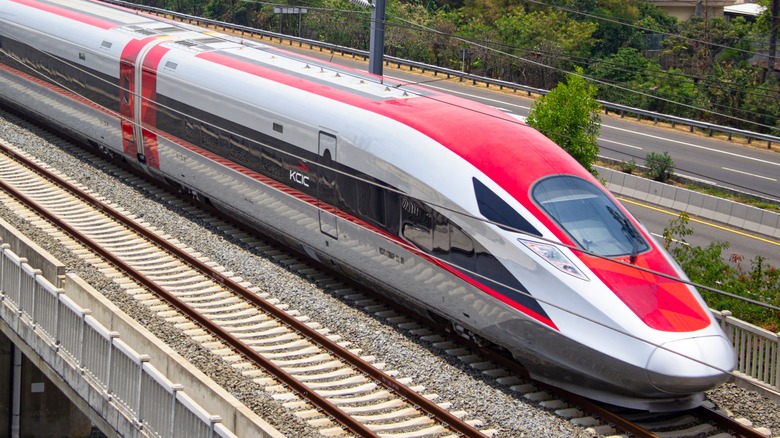
sakti.lin/Shutterstock
It’s no secret that there have been a lot of big moves to expand the railway infrastructure in China over the last couple of decades. The country debuted the world’s longest high-speed rail line back in 2012 and is even planning an undersea railway to Taiwan that will span 135km. Several new train systems have been introduced over the course of this massive transport boom, but few compare to the Fuxing Hao trains, which connect Beijing, Shanghai, Nanjing, Tianjin, Xian, Changsha, Hangzhou, Chengdu, Chongqing, Wuhan, and other cities. As the first set of trains to be designed and manufactured fully in China, these groundbreaking Fuxing Hao trains are the first of their kind.
Advertisement
This family of bullet trains is fast, reliable, and extremely efficient, making them an ideal model for the large-scale production required for China’s massive transit system. It also makes them a solid candidate for replacing the aging Hexie Hao high-speed trains introduced in 2004 and launched in 2012. Hearing that, some of you might be interested in learning more about these fascinating trains. Let’s get into how the Fuxing Hao were developed, what design elements and features set them apart, how fast they run, and what accommodations they offer their passengers.
The Fuxing Hao train development started back in 2012
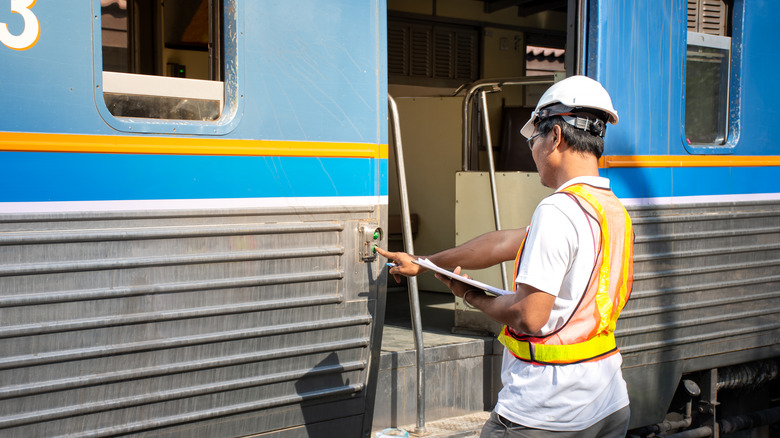
Pitiphat Kanjanamukda/Getty Images
The Fuxing Hao line was designed by two companies. The first was China Railway, a government-owned railroad corporation that built the majority of China’s existing railways and 90% of its electric rails. The second is the Beijing-based corporation, CRRC, a leader in supplying rail transit equipment.
Advertisement
The company reached out to numerous research organizations and manufacturers before deciding to work in collaboration with CRRC. Once the collaboration was agreed upon, Fuxing Hao train development got underway in 2012 when China Railway invested in new technology to advance China’s bullet train infrastructure. The first Fuxing Hao schematics were designed in 2014, and the first test model was revealed in 2015. This initial model received its first test runs later that year. It performed exceptionally well, with a top speed of 239 mph. In 2018, three new models were introduced, each designed to specialize in different use cases.
Fuxing Hao variants come in different shapes and sizes
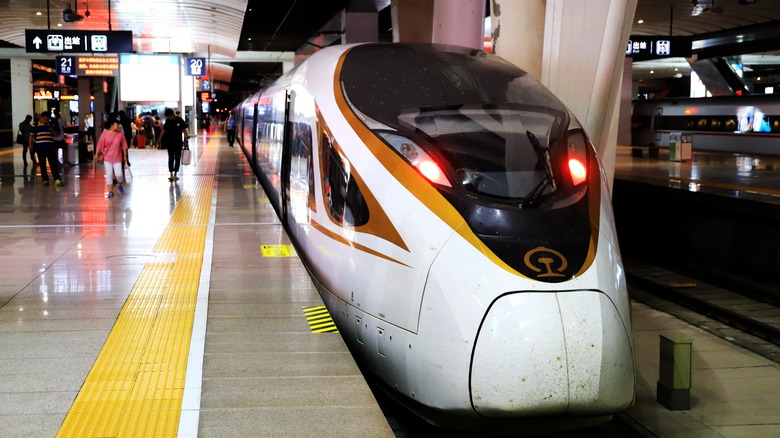
Laser1987/Getty Images
Each Fuxing Hao bullet train has its own unique specifications and features. The CR300BF is 686 feet long and can hold 613 passengers. The CR200J has two different configurations: a short version with capacity for 720 passengers, and a longer version which can hold up to 1,102 people. Then there are the extra-long CR400AF-B and CR400BF-B Fuxing Hao trains. These are 1,444 feet long, sport 17 cars, and hold as many as 1,283 people.
Advertisement
That being said, there are several features that all of the Fuxing Hao trains have in common. One of their most distinguishing characteristics is their aerodynamic design. The Fuxing Hao trains have narrow front ends and other design elements that help reduce wind resistance and make them more energy efficient. In terms of safety, the Fuxing trains each have a monitoring system consisting of 2,500 monitoring ports onboard. This can be used to automatically detect emergency conditions on the train — such as damage or a system malfunction — and slow them down.
Like the Hexie trains before them, Fuxings are designed to operate on the ballastless tracks that China’s high-speed railways are built of. These are traditional railways composed of steel rail and a ballast bed.
Advertisement
The fastest Fuxing Hao can reach 260mph
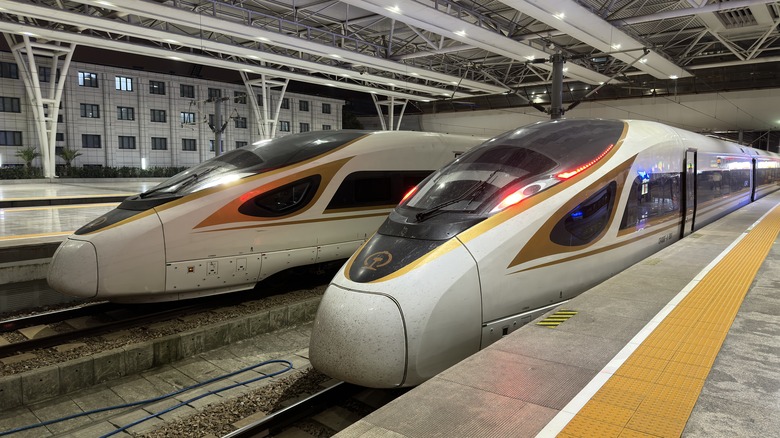
Robert Way/Getty Images
The new Maglev bullet train that was first showcased in 2022 is the fastest train in the Chinese transit system with a whopping top speed of 373 mph. Not only is it China’s fastest train, it’s also one of the fastest ways you could possibly travel on land in general. The Fuxing Hao trains can’t quite hit that mark, but they are still easily considered to be among the fastest.
Advertisement
As there are several different variations of Fuxing Hao trains, it’s worth noting that each of them has a different top speed, and some won’t be quite as fast as others. The slowest of them is the CR200J Fuxing, which has a slightly wider, and therefore more spacious, body than other Fuxing models. This is good for the comfort of passengers, but it means that it can only reach a top speed of 99 mph.
On the other end of the spectrum, you have the CR400 Fuxing. This train has a much higher maximum speed. It is only rated to commercially operate at up to 217 mph, but it has actually been shown to reach a top speed of 260 mph in tests. This means that a Fuxing train could travel the 663 miles from Beijing to Shanghai in as little as roughly four hours. This doesn’t exactly compete with the Shanghai Maglev, but it’s still a fast train.
Advertisement
The inside of a Fuxing Hao train is pretty luxurious
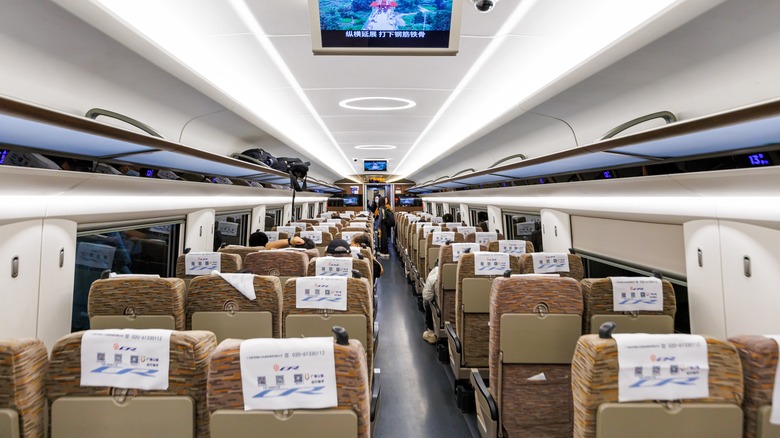
Markus Mainka/Shutterstock
There are several modern amenities onboard the Fuxing trains that make them one of the more comfortable ways you can travel long distances. The entire train has fully automatic doors. There’s unlimited WiFi, and each seat has access to power outlets with USB interfaces for charging devices. Seats are also illuminated with electronic lamps to indicate whether they are available or not, which may make it easier to find a spot if passengers decide to try and buy tickets once they’re already aboard the train.
Advertisement
Several amenities are specific to each class compartment as well. In the economy section, seats are arranged in rows of five, but they are comfortable, offer individual table trays, and can be adjusted. The first-class seats are a bit more spacious, consisting of rows of four across the same width. These come with pillows and footrests and can be adjusted to a full reclining position.
However, the best seats in the house (or train) are those found in Business Class. These are individual, disconnected seats that are organized into rows of three. They are leather-upholstered and have 180-degrees of swivel. Not only that, but they can actually fully convert into a bed. Each seat also comes with a flatscreen TV, table tray, and reading light. Now that’s luxury.
Advertisement